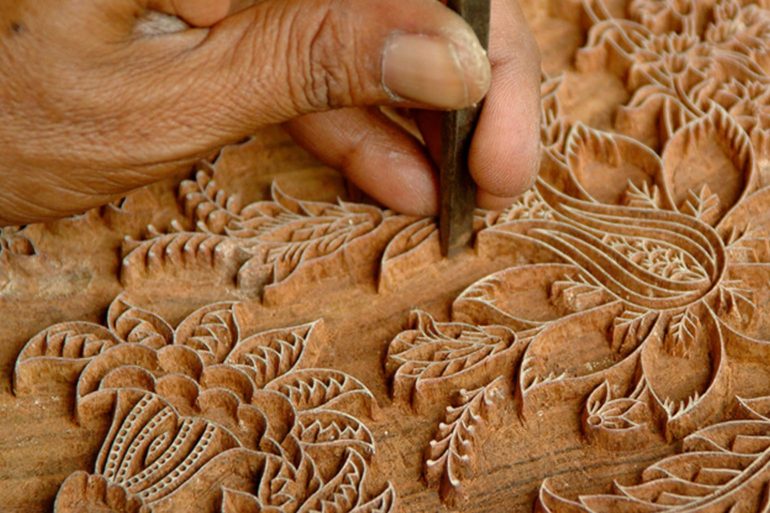Images Courtesy : Anokhi Museum of Hand Printing
While Rajasthan has become a haven for cultural fests in iconic heritage sites, the Anokhi Museum of Hand Printing has been quietly attracting the more curious of travellers. Located at only 10 minutes walking distance from the Amber Fort in Jaipur, the magnificently restored Anokhi Haveli is an absolute must visit.
As intrinsic to Rajasthan is the desert and its palaces, equally characteristic are the vibrant block prints and textiles. It is this very fabric of heritage that the Anokhi brand has persevered to preserve over their 46 years of existence.

Envisioned by Rachel and her husband Pritam Singh, the Anokhi Museum of Hand Printing (AMHP) is dedicated to the art of block printing and aspires to engage fashion designers, textile specialists and the general public alike. The primary motive though, is to encourage the very artisans from the community to visit and view their craft, in a distinct and inspirational way.
Founder & Director, Rachel Bracken Singh shares that, “After a number of years of regularly showing visitors around the Anokhi workplace [we realised that] people visiting Jaipur clearly wanted to learn [more] about block printing – its history, some technical details and the chance to look at both traditional and contemporary examples – and there wasn’t such a place to facilitate that.

While Anokhi’s business and museum are intrinsically linked, the content of the museum is not about Anokhi, it is about block printing as a craft and its unique richness and diversity.”
The museum supports an ongoing research programme to study block printing, particularly select regions of northern India. There is an increasing emphasis on not only detailing technical processes, but also capturing the artisan’s memories and the stories embedded in the cloth. Alongside this research, AMHP has published a series of books with photographs and fabric swatches.
For instance the Balotra project serves to highlight the one remaining family still producing a full repertoire of traditional prints associated with this relatively unknown printing town of Western Rajasthan. The AMHP has also published: Hand Blockopedia ~ A Beginner’s Guide that provides a general overview of the craft including a discussion of select block printing villages and towns; Ajrakh ~ Patterns & Borders & Sanganer ~ Traditional Textiles, Contemporary Cloth with a new publication charted for 2016.


It is in the same vein of empowering the artisans that with the guidance of architects, Nimish Patel & Parul Zaveri (Abhikram), the dilapidated Chanwar Palkiwon ki Haveli mansion was restored to its original grandeur after a 3-year renovation project. It was Museum Consultant, Pramod Kumar (2003-2005) who was in charge of adapting the Haveli, once a rest stop for the palanquin bearers in its haydays, to a Museum suited to modern times. The Anokhi Museum of Hand Printing was awarded for ‘Cultural Heritage Conservation’ by UNESCO in 2000.
The Anokhi Archives is an extensive collection of blocks, block printed textiles, garments and furnishings dating back to the 1960s. Together with Curator, Emma Ronald (2004-2007), Pramod organised the opening exhibition Print Progress ~ Innovation & Revival 1970-2005.

The permanent collections display a range of natural and chemical processes including dabu mud-resist printing, and gold and silver embellishment. Specifically it includes Bagru, Ajrakh & Sangneri styles.
An ongoing research programme, maintained by Suki Skidmore with Rachel since 2007, has resulted in series of publications with related museum exhibitions. Such as, the Bagh project, which is currently on display at the museum draws attention to the skilled printing style of textiles from this small village in Madhya Pradesh. By using works of renowned artisans to compliment a display of contemporary scarf designs by designer Geeta Patil, for Womenweave, its underscores the significance of creative input in keeping traditions dynamic and viable in the modern world.
On asking Rachel what lies ahead, she shares, “we will also focus on the digitisation of all museum archives of fabrics, garments, photographs and objects over the next 2 years. Completion of the next museum publication about the historical block carving and printing town of Farrukhabad is top of our list for 2016!”


You can find the Anokhi Museum of Hand Printing on Facebook & Instagram and follow their blog to know more about the collections and activities. Be sure to check their website for timings on Block Carving & Printing Demos and to know more about their Current Collections.

